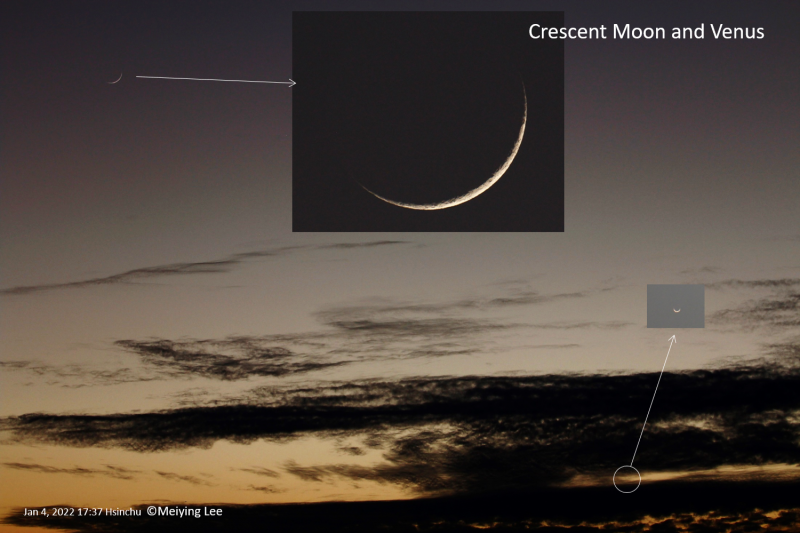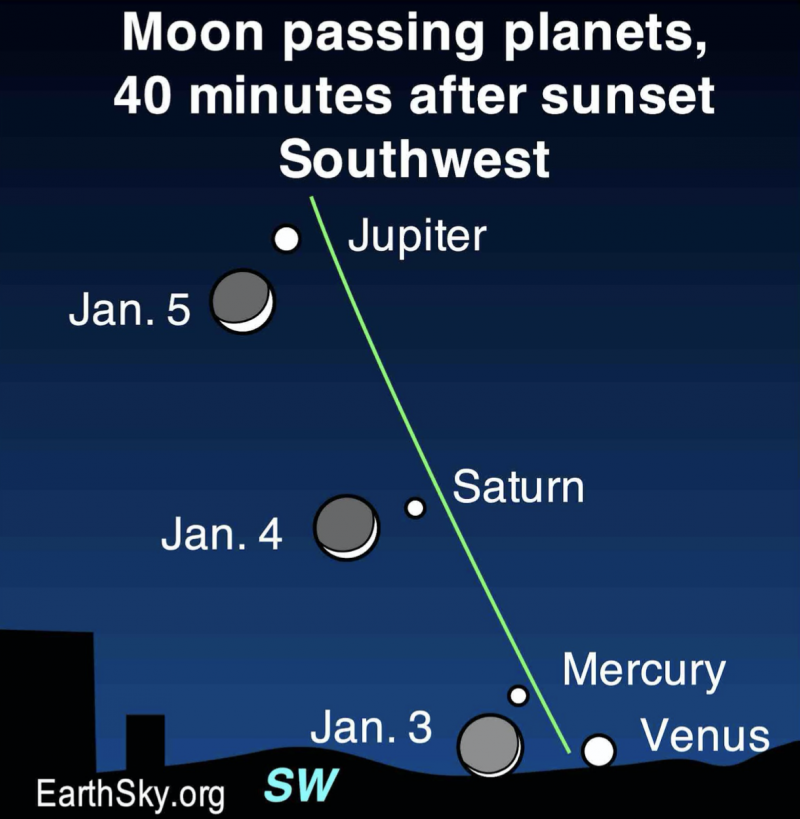
At EarthSky Community Photos, we’ve had multiple images of the crescent Venus over the past several days, as the planet nears its inferior conjunction on January 8-9, 2022 (when it will pass between us and the sun). This image is from last night, from Meiying Lee in Taiwan. She wrote:
Today’s crescent moon is illuminated only by 3.8%, and Venus, which is very close to the sun, is illuminated only 1.0%. Both are very thin and crescent-shaped; especially the small crescent of Venus in the long lens is very beautiful.
Thank you, Meiying! Bruce McClure told us he saw Venus as a crescent with his eye alone:
… I clearly saw Venus as a crescent with the eye alone at evening dusk on January 3. Although I’ve often seen the crescent through binoculars, I don’t know that I’ve ever seen such a perfect and obvious Venusian crescent with the unaided eye. I’m quite excited about it, and wonder if any ancient or prehistoric sky watchers had ever seen Venus as a crescent.
Interesting thought! Thank you, Bruce! By the way, Bruce also mentioned that:
According to the ephemeris for Venus at Fred Espenak’s Astropixels.com, Venus is over one minute (60 seconds) in diameter and less than 2% illuminated, presenting an optimal time for catching the crescent with no optical aid.
If you want to see the crescent Venus for yourself, give it a try. But be careful. Never look at the sun directly, especially with optical aid. Venus will be surprisingly bright for being so near the sunset glare. It’ll be visible only briefly, in the west, shortly after the sun goes down. On the evening of January 5, 2022, the waxing moon will be pointing toward Venus:

Bottom line: An image, and some thoughts, about the crescent moon and crescent Venus.
The post Crescent moon, crescent Venus first appeared on EarthSky.
from EarthSky https://ift.tt/3EXJ58A

At EarthSky Community Photos, we’ve had multiple images of the crescent Venus over the past several days, as the planet nears its inferior conjunction on January 8-9, 2022 (when it will pass between us and the sun). This image is from last night, from Meiying Lee in Taiwan. She wrote:
Today’s crescent moon is illuminated only by 3.8%, and Venus, which is very close to the sun, is illuminated only 1.0%. Both are very thin and crescent-shaped; especially the small crescent of Venus in the long lens is very beautiful.
Thank you, Meiying! Bruce McClure told us he saw Venus as a crescent with his eye alone:
… I clearly saw Venus as a crescent with the eye alone at evening dusk on January 3. Although I’ve often seen the crescent through binoculars, I don’t know that I’ve ever seen such a perfect and obvious Venusian crescent with the unaided eye. I’m quite excited about it, and wonder if any ancient or prehistoric sky watchers had ever seen Venus as a crescent.
Interesting thought! Thank you, Bruce! By the way, Bruce also mentioned that:
According to the ephemeris for Venus at Fred Espenak’s Astropixels.com, Venus is over one minute (60 seconds) in diameter and less than 2% illuminated, presenting an optimal time for catching the crescent with no optical aid.
If you want to see the crescent Venus for yourself, give it a try. But be careful. Never look at the sun directly, especially with optical aid. Venus will be surprisingly bright for being so near the sunset glare. It’ll be visible only briefly, in the west, shortly after the sun goes down. On the evening of January 5, 2022, the waxing moon will be pointing toward Venus:

Bottom line: An image, and some thoughts, about the crescent moon and crescent Venus.
The post Crescent moon, crescent Venus first appeared on EarthSky.
from EarthSky https://ift.tt/3EXJ58A

Aucun commentaire:
Enregistrer un commentaire